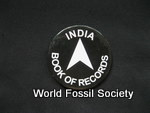@ WFS,World Fossil Society,Riffin T Sajeev,Russel T Sajeev Paleontologists working in Tanzania have identified a new species of hyaenodont, a type of extinct meat-eating mammal. The study is published today, National Fossil Day, in the journal PLOS ONE and funded by the National Science Foundation (NSF). After the extinction of the non-avian dinosaurs 66 million […]
Posts Tagged ‘WFS’
WFS News:Fossil discovery in Tanzania reveals ancient bobcat-sized carnivore
 October 14th, 2017
October 14th, 2017  Riffin
Riffin WFS News: ‘Obscure’ stalked filter feeder lived in Utah some 500 million years ago
 October 12th, 2017
October 12th, 2017  Riffin
Riffin @WFS,World Fossil Society,Riffin T Sajeev,Russel T Sajeev To the untrained eye, it looks like a flower crudely etched into rock — as if a child had scratched a picture of a bloom. But to the late fossil hunter Lloyd Gunther, the tulip shape he unearthed at Antimony Canyon in northern Utah looked like the remnant […]
WFS News:Dinosaur blood? New research urges caution regarding fossilized soft tissue
 October 11th, 2017
October 11th, 2017  Riffin
Riffin @WFS,World Fossil Society,Riffin T Sajeev,Russel T Sajeev Scientists have conducted experiments to accelerate degradation in keratinous tissues such as feathers, scales and hair in order to simulate the processes that occur over deep time as something becomes a fossil. Their findings demonstrate that previous claims showing the preservation of keratin protein in dinosaur fossils are […]
WFS News: Earliest evidence of reproduction in a complex organism
 October 9th, 2017
October 9th, 2017  Riffin
Riffin @ WFS,World Fossil Society,Riffin T Sajeev,Russel T Sajeev Researchers led by the University of Cambridge have found the earliest example of reproduction in a complex organism. Their new study has found that some organisms known as rangeomorphs, which lived 565 million years ago, reproduced by taking a joint approach: they first sent out an ‘advance […]
WFS News:Fossil points to early rise of ancient crocodiles
 October 5th, 2017
October 5th, 2017  Riffin
Riffin @ WFS,World Fossil Society,Riffin T Sajeev,Russel T Sajeev The discovery reveals that an extinct group of aquatic reptiles evolved millions of years earlier than was previously thought, researchers say.The new species was a 10-foot-long animal that lived in the warm, shallow seas that covered much of what is now Europe.Powerful jaws and big, serrated teeth […]
WFS News: Exceptional soft tissues preservation in a mummified frog-eating Eocene salamander
 October 4th, 2017
October 4th, 2017  Riffin
Riffin @ WFS,World Fossil Society,Riffin T Sajeev,Russel T Sajeev A new study on an exceptionally preserved salamander from the Eocene of France reveals that its soft organs are conserved under its skin and bones. Organs preserved in three dimensions include the lung, nerves, gut, and within it, the last meal of the animal, according to a […]
WFS News: The first known neonate Ichthyosaurus communis skeleton
 October 4th, 2017
October 4th, 2017  Riffin
Riffin @WFS,World Fossil Society,Riffin T Sajeev,Russel T Sajeev Scientists from the UK have identified the smallest and youngest specimen of Ichthyosaurus communis on record and found an additional surprise preserved in its stomach. The ichthyosaur fossil has a total length of just around 70 cm and had the remains of a prehistoric squid in its stomach. […]
WFS News: Helicopter lifts chasmosaur fossil with ‘frill’ in Alberta
 October 2nd, 2017
October 2nd, 2017  Riffin
Riffin @ WFS,World Fossil Society,Riffin T Sajeev,Russel T Sajeev Two years after paleontologist Jordan Mallon of the Canadian Museum of Nature and his team discovered the skull of a chasmosaur while going through a dinosaur bonebed in Alberta, he finally got to see a helicopter lift it into the air. “There’s no roads down to the […]
WFS News: how Earth was first formed?
 September 30th, 2017
September 30th, 2017  Riffin
Riffin @WFS,World Fossil Society,Riffin T Sajeev,Russel T Sajeev Oxford University scientists have shed new light on how Earth was first formed. Based on observations of newly-forming stars, scientists know that the solar system began as a disc of dust and gas surrounding the centrally-growing sun. The gas condensed to solids which accumulated into larger rocky bodies […]
WFS News: Utah Paleontologists Turn to Crowdfunding for Raptor Project
 September 29th, 2017
September 29th, 2017  Riffin
Riffin @ WFS,World Fossil Society,Riffin T Sajeev,Russel T sajeev Millions of years ago, on a mud flat somewhere in Cretaceous Utah, a group of Utahraptors made a grave mistake: They tried to hunt near quicksand. The pack’s poor fortune has given modern paleontologists an opportunity to decode the giant raptor — its appearance, growth and behavior […]



 Posted in
Posted in  Tags:
Tags: 
